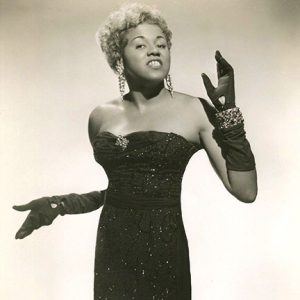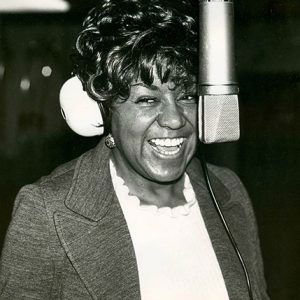calsfoundation@cals.org
Rose Marie McCoy (1922–2015)
Rose Marie Hinton McCoy broke into the white, male-dominated music business in the early 1950s to become a highly sought-after songwriter whose career lasted over six decades. More than 360 artists have recorded her tunes, including Nat King Cole, Elvis Presley, and Sarah Vaughan. She was inducted into the Arkansas Black Hall of Fame in 2008 and the Arkansas Jazz Hall of Fame in 2018.
Marie Hinton was born in Oneida (Phillips County) on April 19, 1922, to Levi Hinton and Celetia Brazil Hinton. She and her older brother and sister attended the area’s two-room elementary school, went to church regularly, and worked on the forty-acre farm their parents rented. Though Oneida was located in the Mississippi Delta, often referred to as the birthplace of the blues, except for the occasional singing of a field hand, the blues was not heard in that small town. Many considered it to be “the devil’s music.”
It was eighteen miles away in Helena (Phillips County) that Marie would become acquainted with the blues, often standing outside a club called The Hole in the Wall to hear top bluesmen perform. Her grandparents lived in Helena, and she was sent there to attend the area’s high school for black students. At Eliza Miller High School, Marie sang in shows and saw top black jazz bands perform. Soon, she was dreaming of becoming a professional singer.
At age eighteen, she legally added Rose to her name, and in 1942, Rose Marie Hinton moved to New York and began singing in small clubs in Harlem. On a trip back to Arkansas in 1943, she married former sweetheart James McCoy, who was in the U.S. Army and getting ready to be sent to Germany; they had no children. While he was away, she began traveling the so-called Chitlin’ Circuit, opening for such top performers as Pigmeat Markham and Moms Mabley.
McCoy had started writing songs when she was a child. The first of her songs to appear on a record was “After All,” recorded in 1946 by a group called the Dixie-aires. Receiving such a small amount of royalties, she decided to concentrate on her singing career.
In 1952, ten years after moving to New York, she recorded two of her songs for Wheeler Records, a new company formed to capitalize on the growing popularity of black music. As soon as her record was released, music publishers began seeking her out, not as a singer as she had hoped, but as a songwriter. One of the first songs she was asked to write reached No. 3 on Billboard’s Rhythm & Blues chart in 1953. “Gabbin’ Blues” gave the singer Big Maybelle her first hit record and McCoy the first of her seven BMI Awards. That same year, Big Maybelle scored another top-ten hit with McCoy’s “Way Back Home.”
At first, McCoy worked on her own, writing both words and music. Then, in 1953, she teamed up with her first writing partner, Charles Singleton. From 1954 to 1956, they wrote seven top-ten hits: “Well All Right” (Big Joe Turner, 1954), “Mambo Baby” (Ruth Brown, 1954), “Hurts Me to My Heart” (Faye Adams, 1954), “Pitter Patter” (Nappy Brown, 1955), “If I May” (Nat King Cole, 1955), “Don’t Take It So Hard” (Earl King, 1955), and “Letter from My Darling” (Little Willie John, 1956). Their song “Trying to Get to You” (1957) was included on Elvis Presley’s first album (1956), and though it did not become a top-ten single, it has been part of many of Presley’s albums and live performances. The song has since been recorded by more than thirty other artists.
Some of her other songwriting partnerships created hits for Nappy Brown (“Don’t Be Angry,” 1955), Elvis Presley (“I Beg of You,” 1957), Ike and Tina Turner (“It’s Gonna Work Out Fine,” 1961), Maxine Brown (“We’ll Cry Together,” 1961), and Jerry Butler (“Got to See if I Can’t Get Mommy to Come Back Home,” 1970). McCoy also produced many recordings, including the five songs she wrote for Sarah Vaughan’s 1974 album Send in the Clowns. She also wrote jingles for artists such as Aretha Franklin and Ray Charles and formed her own publishing firm.
Though having her songs recorded by major artists was getting more and more difficult, McCoy kept promoting her tunes from her office in Manhattan’s iconic Brill Building and later from her home in Teaneck, New Jersey. Her last songs were written with Billy Joe Conor and appear on his 2013 self-titled country album.
Rose Marie McCoy died of pneumonia on January 20, 2015, in Carle Foundation Hospital in Urbana, Illinois.
For additional information:
Clancy, Sean. “Write on, Rose.” Arkansas Democrat-Gazette, November 12, 2017, pp. 1E, 6E.
———. Thought We Were Writing the Blues: But They Called It Rock ’n’ Roll. Tenafly, NJ: ArleneChristine, 2014.
“Lady Writes the Blues: The Rose Marie McCoy Story.” Radio Diaries. http://www.radiodiaries.org/lady-writes-the-blues/ (accessed October 1, 2020).
Roberts, Sam. “Rose Marie McCoy, a Songwriter for Rock, Pop and Jazz Legends, Dies at 92.” New York Times, January 31, 2015. Online at http://www.nytimes.com/2015/02/01/arts/music/rose-marie-mccoy-a-songwriter-for-rock-pop-and-jazz-legends-dies-at-92.html?_r=0 (accessed October 1, 2020).
Rose Marie McCoy Music. http://rosemariemccoymusic.com/ (accessed October 1, 2020).
Arlene Corsano
Bergenfield, New Jersey


 Rose Marie McCoy
Rose Marie McCoy  Rose Marie McCoy
Rose Marie McCoy 



Comments
No comments on this entry yet.